-
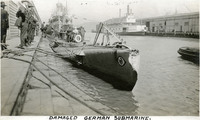 McCarthy Album 05, Photograph 320
McCarthy Album 05, Photograph 320 Caption: "Damaged German Submarine.," c. 1917. Shows the above-water portions of a German U-boat, or submarine, likely docked in either Petaluma or San Francisco, given the presence of a Petaluma and Santa Rosa Railway ferry in the background.
-
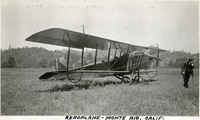 McCarthy Album 05, Photograph 319
McCarthy Album 05, Photograph 319 Caption: "Aeroplane -- Monte Rio,, Calif.," c. 1915. Biplane parked in a field, with an unidentified man on crutches nearby.
-
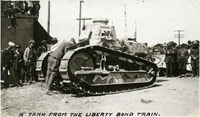 McCarthy Album 05, Photograph 318
McCarthy Album 05, Photograph 318 Caption: "A Tank from the Liberty Bond Train." Shows a Renault FT Tank, a small French tank with caterpillar-style propulsion used during World War I. This tank was displayed as part of the fifth Liberty Bond Drive, held in 1919. During World War I, the U.S. government raised funds for the war by issuing "liberty bonds." Liberty Bond Trains crisscrossed the country to encourage purchase of the bonds. Citizens who purchased the bonds could later redeem them for the purchase price plus interest.
-
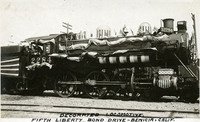 McCarthy Album 05, Photograph 317
McCarthy Album 05, Photograph 317 Caption: "Decorated Locomotive. Fifth Liberty Bond Drive -- Benicia, Calif." During World War I, the U.S. government raised funds for the war by issuing "liberty bonds." Citizens who purchased the bonds could later redeem them for the purchase price plus interest. Liberty Bond Drives were held to encourage people to purchase the bonds. This photograph shows a locomotive employed in the fifth Liberty Bond Drive, held in 1919. Decorated with bunting and flags to inspire patriotic feeling, Liberty Bond Trains crisscrossed the U.S. to round up funding.
-
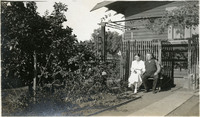 McCarthy Album 05, Photograph 316
McCarthy Album 05, Photograph 316 No caption, c. 1915. Two unidentified people sitting on a bench overlooking a garden.
-
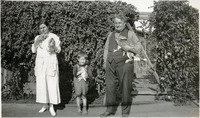 McCarthy Album 05, Photograph 315
McCarthy Album 05, Photograph 315 No caption, c. 1915. Two unidentified adults and one unidentified child posing in front of a hedge. All three are holding rabbits of varying sizes.
-
 McCarthy Album 05, Photograph 314
McCarthy Album 05, Photograph 314 No caption, c. 1915. Two unidentified people posing on a porch.
-
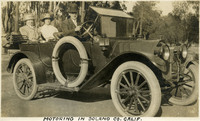 McCarthy Album 05, Photograph 313
McCarthy Album 05, Photograph 313 Caption: "Motoring in Solano Co. Calif.," c. 1915. William (driver's seat) and Grace (rear seat, at right) McCarthy posing in an automobile with an unidentified woman.
-
 McCarthy Album 05, Photograph 312
McCarthy Album 05, Photograph 312 No caption, c. 1915. William (driver's seat) and Grace (front passenger seat) McCarthy posing in an automobile with a group of unidentified friends and/or family members.
-
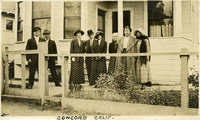 McCarthy Album 05, Photograph 311
McCarthy Album 05, Photograph 311 No caption: "Concord Calif.," c. 1915. Group of unidentified people posing in front of a residence in Concord, California.
-
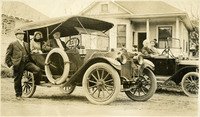 McCarthy Album 05, Photograph 310
McCarthy Album 05, Photograph 310 No caption, c. 1915. Several unidentified people posing in two automobiles in front of a residence in Concord, California.
-
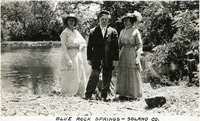 McCarthy Album 05, Photograph 309
McCarthy Album 05, Photograph 309 Caption: "Blue Rock Springs -- Solano Co.," c. 1915. Grace McCarthy (far left) and two unidentified friends or relatives at what is now known as Blue Rock Springs. In the 1860s, White Sulphur Springs (in the vicinity of Vallejo) was developed for use as a mineral springs resort, featuring a hotel, several cottages, and an "amusement" building with a dance floor, bar, and billiard room. Manuel Madrid obtained the property around the turn of the twentieth century, and changed the name to Blue Rock Springs. The area is now managed by the Greater Vallejo Recreation District as Blue Rock Springs Park.
-
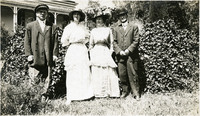 McCarthy Album 05, Photograph 308
McCarthy Album 05, Photograph 308 No caption, c. 1915. William (far right) and Grace (second from left) standing with unidentified friends or family in a garden or yard, possibly in the vicinity of Blue Rock Springs, Solano County.
-
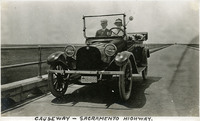 McCarthy Album 05, Photograph 307
McCarthy Album 05, Photograph 307 Caption: "Causeway -- Sacramento Highway." William and Grace McCarthy driving over the newly-constructed Yolo Causeway, an elevated stretch of I-80 that connects what is now West Sacramento with Davis by traveling across the Yolo Bypass. The Yolo Causeway's official name is Blecher-Freeman Memorial Causeway.
-
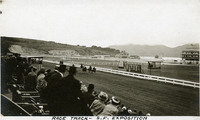 McCarthy Album 05, Photograph 306
McCarthy Album 05, Photograph 306 Caption: "Race Track -- S.F. Exposition." Race track at San Francisco's Panama-Pacific International Exposition, held in 1915. A horse race is in progress, with several spectators out of their seats in anticipation of the finish.
-
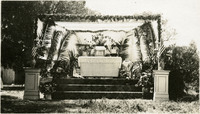 McCarthy Album 05, Photograph 305
McCarthy Album 05, Photograph 305 No caption, undated. Depicts a temporary memorial of some kind, possibly a funeral arrangement, with a cloth canopy over a podium upon which sits a covered table or small casket, with a cross and decorative flowers and palm fronds. Stairs leading to the podium are bracketed by small pedestals topped by vases holding American flags.
-
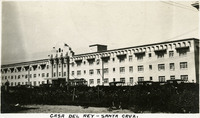 McCarthy Album 05, Photograph 304
McCarthy Album 05, Photograph 304 Caption: "Casa Del Rey -- Santa Cruz.," c. 1911. View of the resort hotel known as Casa del Rey, built in 1911 in Santa Cruz. The hotel operated until sustaining significant damage in the 1989 Loma Prieta earthquake. The building was subsequently demolished.
-
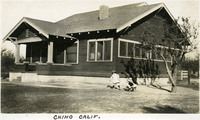 McCarthy Album 05, Photograph 303
McCarthy Album 05, Photograph 303 Caption: "Chino Calif.," c. 1915. Unidentified child pulling another unidentified, smaller child in a wagon in front of a Craftsman-style residence.
-
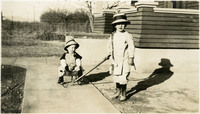 McCarthy Album 05, Photograph 302
McCarthy Album 05, Photograph 302 No caption, c. 1915. Unidentified child pulling another unidentified, smaller child in a wagon.
-
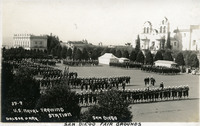 McCarthy Album 05, Photograph 301
McCarthy Album 05, Photograph 301 Caption: "San Diego Fair Grounds." and "39-9, U.S. Naval Training Station, Balboa Park, San Diego," c. 1917. With the advent of World War I, the U.S. Navy needed additional training grounds for sailors. In 1917, the City of San Diego offered to lease the Navy a portion of Balboa Park as a temporary training site until a new, more permanent facility could be constructed. This postcard shows groups of sailors drilling in formation while a small crowd watches.
-
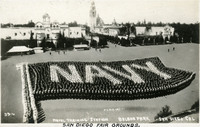 McCarthy Album 05, Photograph 300
McCarthy Album 05, Photograph 300 Caption: "San Diego Fair Grounds." and "39-6, 3,400 Men, Naval Training Station, Balboa Park, San Diego Cal.," c. 1917. With the advent of World War I, the U.S. Navy needed additional training grounds for sailors. In 1917, the City of San Diego offered to lease the Navy a portion of Balboa Park as a temporary training site until a new, more permanent facility could be constructed. This postcard shows 3,400 sailors lined up to form a Navy flag while at the temporary training ground.
-
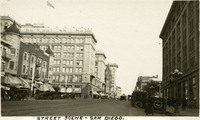 McCarthy Album 05, Photograph 299
McCarthy Album 05, Photograph 299 Caption: "Street Scene -- San Diego.," c. 1910. Street-level view of street in San Diego. The U.S. Grant Hotel rises above the surrounding buildings in the center of the photograph.
-
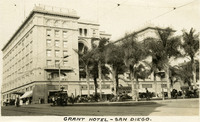 McCarthy Album 05, Photograph 298
McCarthy Album 05, Photograph 298 Caption: "Grant Hotel -- San Diego," c. 1910. View of the U.S. Grant Hotel, built by the son of Ulysses S. Grant (Union General and 18th President of the U.S.), who named the hotel for his father. The building, designed by Harrison Albright, opened for business in October 1910.
-
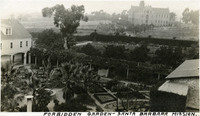 McCarthy Album 05, Photograph 297
McCarthy Album 05, Photograph 297 Caption: "Forbidden Garden -- Santa Barbara Mission," c. 1910. View of the gardens associated with Santa Barbara Mission. The gardens initially served as the location for instructing neophytes (Native American converts living at the mission) in trades and skills deemed necessary to life in European civilization. Later, the garden was used for meditation. The garden was often dubbed "forbidden" because it was closed to female visitors, as were many enclosures in active missions.
-
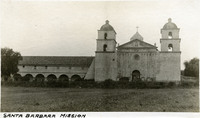 McCarthy Album 05, Photograph 296
McCarthy Album 05, Photograph 296 Caption: "Santa Barbara Mission," c. 1910. View of Mission Santa Barbara, established by Spanish Franciscan monks in 1786.
-
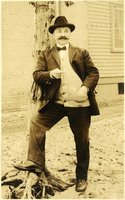 McCarthy Album 05, Photograph 295
McCarthy Album 05, Photograph 295 No caption, c. 1910. Unidentified man leaning against tree.
-
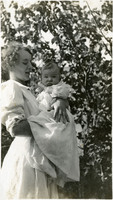 McCarthy Album 05, Photograph 294
McCarthy Album 05, Photograph 294 No caption, c. 1910. Unidentified woman holding a baby while standing in a park or garden.
-
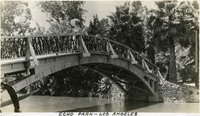 McCarthy Album 05, Photograph 293
McCarthy Album 05, Photograph 293 Caption: "Echo Park [sic] -- Los Angeles," c. 1910. Grace McCarthy standing on a bridge in Los Angeles' Echo Lake Park. The park opened in 1895. The lake was originally created in 1868 to support the operations of a mill. The mill, however, closed seven years later. The site was later selected for conversion to a city park.
-
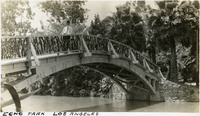 McCarthy Album 05, Photograph 292
McCarthy Album 05, Photograph 292 Caption: "Echo Park [sic] Los Angeles," c. 1910. William McCarthy standing on a bridge in Los Angeles' Echo Lake Park. The park opened in 1895. The lake was originally created in 1868 to support the operations of a mill. The mill, however, closed seven years later. The site was later selected for conversion to a city park.
-
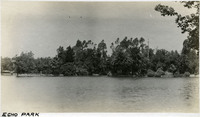 McCarthy Album 05, Photograph 291
McCarthy Album 05, Photograph 291 Caption: "Echo Park [sic] Los Angeles," c. 1910. View across Echo Lake at lush vegetation along the far lake edge. Echo Lake Park opened in 1895. The lake was originally created in 1868 to support the operations of a mill. The mill, however, closed seven years later. The site was later selected for conversion to a city park.
-
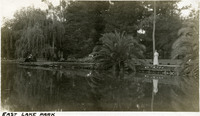 McCarthy Album 05, Photograph 290
McCarthy Album 05, Photograph 290 Caption: "East Lake [sic] Park," c. 1910. Eastlake Park in Los Angeles was originally created by the city in 1881 under the name "East Los Angeles Park." Renamed Eastlake Park in 1901, it gained its current name, Lincoln Park, in 1917. In this photograph, Grace McCarthy, seen from across East Lake, stands at the lake's edge on the right, surrounded by lush vegetation and park benches.
-
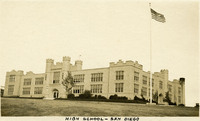 McCarthy Album 05, Photograph 289
McCarthy Album 05, Photograph 289 Caption: "High School -- San Diego," c. 1910. By 1902 San Diego's schools had become overcrowded enough to warrant the construction of a new high school building. Completed in 1907 and designed by F.S. Allen, the new building was quickly nicknamed the "Grey Castle on the Hill" in reference to its castle-like parapets and towers. The Grey Castle was torn down in 1975 to make way for a facility in compliance with new earthquake safety laws.
-
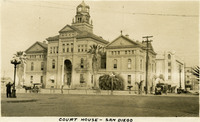 McCarthy Album 05, Photograph 288
McCarthy Album 05, Photograph 288 Caption: "Court House -- San Diego," c. 1910. View of the second courthouse built by San Diego County, completed in 1889. Designed by architectural firm Cornstock & Trotsche of San Francisco, this elaborate building featured a bell and clock tower, statues of four presidents, and 42 stained-glass windows honoring each state in the Union at the time of installation. The tower was removed in 1939. Twenty years later, the entire building was demolished in favor of a newer facility.
-
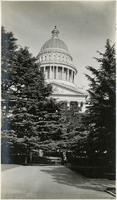 McCarthy Album 05, Photograph 287
McCarthy Album 05, Photograph 287 No caption, c. 1910. View of the California State Capitol Building. Trees obscure much of the building.
-
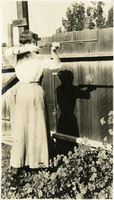 McCarthy Album 05, Photograph 286
McCarthy Album 05, Photograph 286 Caption: "A Holdup," c. 1910. Grace McCarthy standing in a yard or garden aiming a rifle at an unseen target.
-
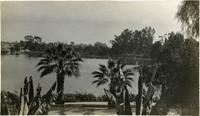 McCarthy Album 05, Photograph 285
McCarthy Album 05, Photograph 285 No caption, undated. Image of unidentified lake and surrounding park.
-
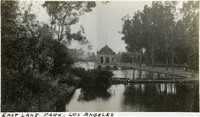 McCarthy Album 05, Photograph 284
McCarthy Album 05, Photograph 284 Caption: "East Lake [sic] Park, Los Angeles," c. 1906. Eastlake Park in Los Angeles was originally created by the city in 1881 under the name "East Los Angeles Park." Renamed Eastlake Park in 1901, it gained its current name, Lincoln Park, in 1917. This photograph shows the park's elaborate bandstand and portions of the lake for which the park is named.
-
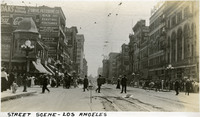 McCarthy Album 05, Photograph 283
McCarthy Album 05, Photograph 283 Caption: "Street Scene -- Los Angeles," c. 1910. Street-level view of an unidentified busy street in Los Angeles.
-
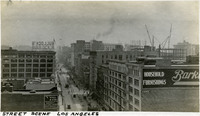 McCarthy Album 05, Photograph 282
McCarthy Album 05, Photograph 282 Caption: "Street Scene -- Los Angeles," c. 1910. Rooftop view of an unidentified street in Los Angeles.
-
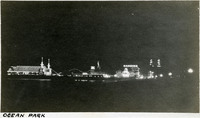 McCarthy Album 05, Photograph 281
McCarthy Album 05, Photograph 281 Caption: "Ocean Park," c. 1910. Night view of amusement zone at what became Venice, California. In 1905, Abbot Kinney built a series of canals as part of a development project along Santa Monica Beach, hoping to recreate the look and feel of Italy's iconic "Floating City" in southern California. Called Ocean Park at first, in 1911, the name officially changed to Venice. By 1929, however, many of the canals had been filled in to create roadways, and those that remained fell into disrepair. A revitalization movement in the early 1990s has restored some of the canals, and made the area a desirable residential neighborhood.
-
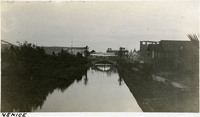 McCarthy Album 05, Photograph 280
McCarthy Album 05, Photograph 280 Caption: "Venice," c. 1911. View of canal and bridge in Venice, California, with amusement "zone" in the distance. In 1905, Abbot Kinney built a series of canals as part of a development project along Santa Monica Beach, hoping to recreate the look and feel of Italy's iconic "Floating City" in southern California. Called Ocean Park at first, in 1911, the name officially changed to Venice. By 1929, however, many of the canals had been filled in to create roadways, and those that remained fell into disrepair. A revitalization movement in the early 1990s has restored some of the canals, and made the area a desirable residential neighborhood.
-
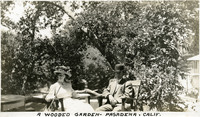 McCarthy Album 05, Photograph 279
McCarthy Album 05, Photograph 279 Caption: "A Wooded Garden -- Pasadena, Calif.," c. 1910. William and Grace McCarthy seated in chairs beneath a tree in a garden.
-
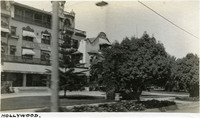 McCarthy Album 05, Photograph 278
McCarthy Album 05, Photograph 278 Caption: "Hollywood.," c. 1915. Street scene in Hollywood, California. The Hotel Hollywood is visible at the left side of the photograph. The hotel, originally built in 1902 and expanded in 1905, served as a social venue for many of Hollywood's early film stars. It was torn down in 1956 to make way for an office building.
-
McCarthy Album 05, Photograph 277
No Photograph 277 exists in Album 05, the number having apparently been skipped when the photographs were labeled.
-
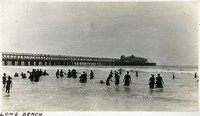 McCarthy Album 05, Photograph 276
McCarthy Album 05, Photograph 276 Caption: "Long Beach," c. 1910. Bathers enjoying the surf at Long Beach. Long Beach pier runs through the center of the photograph.
-
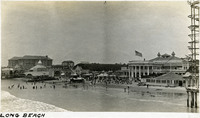 McCarthy Album 05, Photograph 275
McCarthy Album 05, Photograph 275 Caption: "Long Beach," c. 1910. View of The Pike, an amusement zone along the beach front in Long Beach. The framework for the Bisby's Spiral Airship ride can be seen at the far right of the photograph.
-
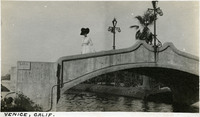 McCarthy Album 05, Photograph 274
McCarthy Album 05, Photograph 274 Caption: "Venice, Calif," c. 1911. Unidentified woman standing on a bridge over Lion Canal in Venice, California. In 1905, Abbot Kinney built a series of canals as part of a development project along Santa Monica Beach, hoping to recreate the look and feel of Italy's iconic "Floating City" in southern California. Called Ocean Park at first, gondoliers sailed boats under elegant bridges such as the one shown in this photograph, in an effort to attract businesses, residents, and investors. In 1911, the name officially changed to Venice. By 1929, however, many of the canals had been filled in to create roadways, and those canals that remained fell into disrepair. A revitalization movement in the early 1990s has restored some of the canals, and made the area a desirable residential neighborhood.
-
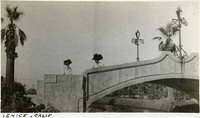 McCarthy Album 05, Photograph 273
McCarthy Album 05, Photograph 273 Caption: "Venice, Calif," c. 1911. Grace McCarthy and an unidentified woman standing on a bridge over Lion Canal in Venice, California. In 1905, Abbot Kinney built a series of canals as part of a development project along Santa Monica Beach, hoping to recreate the look and feel of Italy's iconic "Floating City" in southern California. Called Ocean Park at first, gondoliers sailed boats under elegant bridges such as the one shown in this photograph, in an effort to attract businesses, residents, and investors. In 1911, the name officially changed to Venice. By 1929, however, many of the canals had been filled in to create roadways, and those canals that remained fell into disrepair. A revitalization movement in the early 1990s has restored some of the canals, and made the area a desirable residential neighborhood.
-
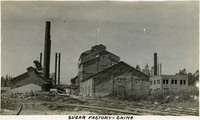 McCarthy Album 05, Photograph 272
McCarthy Album 05, Photograph 272 Caption: "Sugar Factory -- Chino," c. 1915. View of Chino's sugar beet factory, established in 1891 by Robert and Henry Oxnard. Henry later established a larger factory in the town that now bears his name (Oxnard, in Ventura County). The factory operated for more than twenty-five years before closing in October 1917.
-
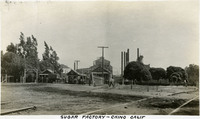 McCarthy Album 05, Photograph 271
McCarthy Album 05, Photograph 271 Caption: "Sugar Factory -- Chino Calif," c. 1915. Chino's sugar beet factory, shown in this photograph, was established in 1891 by Robert and Henry Oxnard. Henry later established a larger factory in the town that now bears his name (Oxnard, in Ventura County). The Chino factory operated for more than twenty-five years before closing in October 1917.
 McCarthy Album 05, Photograph 320 Caption: "Damaged German Submarine.," c. 1917. Shows the above-water portions of a German U-boat, or submarine, likely docked in either Petaluma or San Francisco, given the presence of a Petaluma and Santa Rosa Railway ferry in the background.
McCarthy Album 05, Photograph 320 Caption: "Damaged German Submarine.," c. 1917. Shows the above-water portions of a German U-boat, or submarine, likely docked in either Petaluma or San Francisco, given the presence of a Petaluma and Santa Rosa Railway ferry in the background. McCarthy Album 05, Photograph 319 Caption: "Aeroplane -- Monte Rio,, Calif.," c. 1915. Biplane parked in a field, with an unidentified man on crutches nearby.
McCarthy Album 05, Photograph 319 Caption: "Aeroplane -- Monte Rio,, Calif.," c. 1915. Biplane parked in a field, with an unidentified man on crutches nearby. McCarthy Album 05, Photograph 318 Caption: "A Tank from the Liberty Bond Train." Shows a Renault FT Tank, a small French tank with caterpillar-style propulsion used during World War I. This tank was displayed as part of the fifth Liberty Bond Drive, held in 1919. During World War I, the U.S. government raised funds for the war by issuing "liberty bonds." Liberty Bond Trains crisscrossed the country to encourage purchase of the bonds. Citizens who purchased the bonds could later redeem them for the purchase price plus interest.
McCarthy Album 05, Photograph 318 Caption: "A Tank from the Liberty Bond Train." Shows a Renault FT Tank, a small French tank with caterpillar-style propulsion used during World War I. This tank was displayed as part of the fifth Liberty Bond Drive, held in 1919. During World War I, the U.S. government raised funds for the war by issuing "liberty bonds." Liberty Bond Trains crisscrossed the country to encourage purchase of the bonds. Citizens who purchased the bonds could later redeem them for the purchase price plus interest. McCarthy Album 05, Photograph 317 Caption: "Decorated Locomotive. Fifth Liberty Bond Drive -- Benicia, Calif." During World War I, the U.S. government raised funds for the war by issuing "liberty bonds." Citizens who purchased the bonds could later redeem them for the purchase price plus interest. Liberty Bond Drives were held to encourage people to purchase the bonds. This photograph shows a locomotive employed in the fifth Liberty Bond Drive, held in 1919. Decorated with bunting and flags to inspire patriotic feeling, Liberty Bond Trains crisscrossed the U.S. to round up funding.
McCarthy Album 05, Photograph 317 Caption: "Decorated Locomotive. Fifth Liberty Bond Drive -- Benicia, Calif." During World War I, the U.S. government raised funds for the war by issuing "liberty bonds." Citizens who purchased the bonds could later redeem them for the purchase price plus interest. Liberty Bond Drives were held to encourage people to purchase the bonds. This photograph shows a locomotive employed in the fifth Liberty Bond Drive, held in 1919. Decorated with bunting and flags to inspire patriotic feeling, Liberty Bond Trains crisscrossed the U.S. to round up funding. McCarthy Album 05, Photograph 316 No caption, c. 1915. Two unidentified people sitting on a bench overlooking a garden.
McCarthy Album 05, Photograph 316 No caption, c. 1915. Two unidentified people sitting on a bench overlooking a garden. McCarthy Album 05, Photograph 315 No caption, c. 1915. Two unidentified adults and one unidentified child posing in front of a hedge. All three are holding rabbits of varying sizes.
McCarthy Album 05, Photograph 315 No caption, c. 1915. Two unidentified adults and one unidentified child posing in front of a hedge. All three are holding rabbits of varying sizes. McCarthy Album 05, Photograph 314 No caption, c. 1915. Two unidentified people posing on a porch.
McCarthy Album 05, Photograph 314 No caption, c. 1915. Two unidentified people posing on a porch. McCarthy Album 05, Photograph 313 Caption: "Motoring in Solano Co. Calif.," c. 1915. William (driver's seat) and Grace (rear seat, at right) McCarthy posing in an automobile with an unidentified woman.
McCarthy Album 05, Photograph 313 Caption: "Motoring in Solano Co. Calif.," c. 1915. William (driver's seat) and Grace (rear seat, at right) McCarthy posing in an automobile with an unidentified woman. McCarthy Album 05, Photograph 312 No caption, c. 1915. William (driver's seat) and Grace (front passenger seat) McCarthy posing in an automobile with a group of unidentified friends and/or family members.
McCarthy Album 05, Photograph 312 No caption, c. 1915. William (driver's seat) and Grace (front passenger seat) McCarthy posing in an automobile with a group of unidentified friends and/or family members. McCarthy Album 05, Photograph 311 No caption: "Concord Calif.," c. 1915. Group of unidentified people posing in front of a residence in Concord, California.
McCarthy Album 05, Photograph 311 No caption: "Concord Calif.," c. 1915. Group of unidentified people posing in front of a residence in Concord, California. McCarthy Album 05, Photograph 310 No caption, c. 1915. Several unidentified people posing in two automobiles in front of a residence in Concord, California.
McCarthy Album 05, Photograph 310 No caption, c. 1915. Several unidentified people posing in two automobiles in front of a residence in Concord, California. McCarthy Album 05, Photograph 309 Caption: "Blue Rock Springs -- Solano Co.," c. 1915. Grace McCarthy (far left) and two unidentified friends or relatives at what is now known as Blue Rock Springs. In the 1860s, White Sulphur Springs (in the vicinity of Vallejo) was developed for use as a mineral springs resort, featuring a hotel, several cottages, and an "amusement" building with a dance floor, bar, and billiard room. Manuel Madrid obtained the property around the turn of the twentieth century, and changed the name to Blue Rock Springs. The area is now managed by the Greater Vallejo Recreation District as Blue Rock Springs Park.
McCarthy Album 05, Photograph 309 Caption: "Blue Rock Springs -- Solano Co.," c. 1915. Grace McCarthy (far left) and two unidentified friends or relatives at what is now known as Blue Rock Springs. In the 1860s, White Sulphur Springs (in the vicinity of Vallejo) was developed for use as a mineral springs resort, featuring a hotel, several cottages, and an "amusement" building with a dance floor, bar, and billiard room. Manuel Madrid obtained the property around the turn of the twentieth century, and changed the name to Blue Rock Springs. The area is now managed by the Greater Vallejo Recreation District as Blue Rock Springs Park. McCarthy Album 05, Photograph 308 No caption, c. 1915. William (far right) and Grace (second from left) standing with unidentified friends or family in a garden or yard, possibly in the vicinity of Blue Rock Springs, Solano County.
McCarthy Album 05, Photograph 308 No caption, c. 1915. William (far right) and Grace (second from left) standing with unidentified friends or family in a garden or yard, possibly in the vicinity of Blue Rock Springs, Solano County. McCarthy Album 05, Photograph 307 Caption: "Causeway -- Sacramento Highway." William and Grace McCarthy driving over the newly-constructed Yolo Causeway, an elevated stretch of I-80 that connects what is now West Sacramento with Davis by traveling across the Yolo Bypass. The Yolo Causeway's official name is Blecher-Freeman Memorial Causeway.
McCarthy Album 05, Photograph 307 Caption: "Causeway -- Sacramento Highway." William and Grace McCarthy driving over the newly-constructed Yolo Causeway, an elevated stretch of I-80 that connects what is now West Sacramento with Davis by traveling across the Yolo Bypass. The Yolo Causeway's official name is Blecher-Freeman Memorial Causeway. McCarthy Album 05, Photograph 306 Caption: "Race Track -- S.F. Exposition." Race track at San Francisco's Panama-Pacific International Exposition, held in 1915. A horse race is in progress, with several spectators out of their seats in anticipation of the finish.
McCarthy Album 05, Photograph 306 Caption: "Race Track -- S.F. Exposition." Race track at San Francisco's Panama-Pacific International Exposition, held in 1915. A horse race is in progress, with several spectators out of their seats in anticipation of the finish. McCarthy Album 05, Photograph 305 No caption, undated. Depicts a temporary memorial of some kind, possibly a funeral arrangement, with a cloth canopy over a podium upon which sits a covered table or small casket, with a cross and decorative flowers and palm fronds. Stairs leading to the podium are bracketed by small pedestals topped by vases holding American flags.
McCarthy Album 05, Photograph 305 No caption, undated. Depicts a temporary memorial of some kind, possibly a funeral arrangement, with a cloth canopy over a podium upon which sits a covered table or small casket, with a cross and decorative flowers and palm fronds. Stairs leading to the podium are bracketed by small pedestals topped by vases holding American flags. McCarthy Album 05, Photograph 304 Caption: "Casa Del Rey -- Santa Cruz.," c. 1911. View of the resort hotel known as Casa del Rey, built in 1911 in Santa Cruz. The hotel operated until sustaining significant damage in the 1989 Loma Prieta earthquake. The building was subsequently demolished.
McCarthy Album 05, Photograph 304 Caption: "Casa Del Rey -- Santa Cruz.," c. 1911. View of the resort hotel known as Casa del Rey, built in 1911 in Santa Cruz. The hotel operated until sustaining significant damage in the 1989 Loma Prieta earthquake. The building was subsequently demolished. McCarthy Album 05, Photograph 303 Caption: "Chino Calif.," c. 1915. Unidentified child pulling another unidentified, smaller child in a wagon in front of a Craftsman-style residence.
McCarthy Album 05, Photograph 303 Caption: "Chino Calif.," c. 1915. Unidentified child pulling another unidentified, smaller child in a wagon in front of a Craftsman-style residence. McCarthy Album 05, Photograph 302 No caption, c. 1915. Unidentified child pulling another unidentified, smaller child in a wagon.
McCarthy Album 05, Photograph 302 No caption, c. 1915. Unidentified child pulling another unidentified, smaller child in a wagon. McCarthy Album 05, Photograph 301 Caption: "San Diego Fair Grounds." and "39-9, U.S. Naval Training Station, Balboa Park, San Diego," c. 1917. With the advent of World War I, the U.S. Navy needed additional training grounds for sailors. In 1917, the City of San Diego offered to lease the Navy a portion of Balboa Park as a temporary training site until a new, more permanent facility could be constructed. This postcard shows groups of sailors drilling in formation while a small crowd watches.
McCarthy Album 05, Photograph 301 Caption: "San Diego Fair Grounds." and "39-9, U.S. Naval Training Station, Balboa Park, San Diego," c. 1917. With the advent of World War I, the U.S. Navy needed additional training grounds for sailors. In 1917, the City of San Diego offered to lease the Navy a portion of Balboa Park as a temporary training site until a new, more permanent facility could be constructed. This postcard shows groups of sailors drilling in formation while a small crowd watches. McCarthy Album 05, Photograph 300 Caption: "San Diego Fair Grounds." and "39-6, 3,400 Men, Naval Training Station, Balboa Park, San Diego Cal.," c. 1917. With the advent of World War I, the U.S. Navy needed additional training grounds for sailors. In 1917, the City of San Diego offered to lease the Navy a portion of Balboa Park as a temporary training site until a new, more permanent facility could be constructed. This postcard shows 3,400 sailors lined up to form a Navy flag while at the temporary training ground.
McCarthy Album 05, Photograph 300 Caption: "San Diego Fair Grounds." and "39-6, 3,400 Men, Naval Training Station, Balboa Park, San Diego Cal.," c. 1917. With the advent of World War I, the U.S. Navy needed additional training grounds for sailors. In 1917, the City of San Diego offered to lease the Navy a portion of Balboa Park as a temporary training site until a new, more permanent facility could be constructed. This postcard shows 3,400 sailors lined up to form a Navy flag while at the temporary training ground. McCarthy Album 05, Photograph 299 Caption: "Street Scene -- San Diego.," c. 1910. Street-level view of street in San Diego. The U.S. Grant Hotel rises above the surrounding buildings in the center of the photograph.
McCarthy Album 05, Photograph 299 Caption: "Street Scene -- San Diego.," c. 1910. Street-level view of street in San Diego. The U.S. Grant Hotel rises above the surrounding buildings in the center of the photograph. McCarthy Album 05, Photograph 298 Caption: "Grant Hotel -- San Diego," c. 1910. View of the U.S. Grant Hotel, built by the son of Ulysses S. Grant (Union General and 18th President of the U.S.), who named the hotel for his father. The building, designed by Harrison Albright, opened for business in October 1910.
McCarthy Album 05, Photograph 298 Caption: "Grant Hotel -- San Diego," c. 1910. View of the U.S. Grant Hotel, built by the son of Ulysses S. Grant (Union General and 18th President of the U.S.), who named the hotel for his father. The building, designed by Harrison Albright, opened for business in October 1910. McCarthy Album 05, Photograph 297 Caption: "Forbidden Garden -- Santa Barbara Mission," c. 1910. View of the gardens associated with Santa Barbara Mission. The gardens initially served as the location for instructing neophytes (Native American converts living at the mission) in trades and skills deemed necessary to life in European civilization. Later, the garden was used for meditation. The garden was often dubbed "forbidden" because it was closed to female visitors, as were many enclosures in active missions.
McCarthy Album 05, Photograph 297 Caption: "Forbidden Garden -- Santa Barbara Mission," c. 1910. View of the gardens associated with Santa Barbara Mission. The gardens initially served as the location for instructing neophytes (Native American converts living at the mission) in trades and skills deemed necessary to life in European civilization. Later, the garden was used for meditation. The garden was often dubbed "forbidden" because it was closed to female visitors, as were many enclosures in active missions. McCarthy Album 05, Photograph 296 Caption: "Santa Barbara Mission," c. 1910. View of Mission Santa Barbara, established by Spanish Franciscan monks in 1786.
McCarthy Album 05, Photograph 296 Caption: "Santa Barbara Mission," c. 1910. View of Mission Santa Barbara, established by Spanish Franciscan monks in 1786. McCarthy Album 05, Photograph 295 No caption, c. 1910. Unidentified man leaning against tree.
McCarthy Album 05, Photograph 295 No caption, c. 1910. Unidentified man leaning against tree. McCarthy Album 05, Photograph 294 No caption, c. 1910. Unidentified woman holding a baby while standing in a park or garden.
McCarthy Album 05, Photograph 294 No caption, c. 1910. Unidentified woman holding a baby while standing in a park or garden. McCarthy Album 05, Photograph 293 Caption: "Echo Park [sic] -- Los Angeles," c. 1910. Grace McCarthy standing on a bridge in Los Angeles' Echo Lake Park. The park opened in 1895. The lake was originally created in 1868 to support the operations of a mill. The mill, however, closed seven years later. The site was later selected for conversion to a city park.
McCarthy Album 05, Photograph 293 Caption: "Echo Park [sic] -- Los Angeles," c. 1910. Grace McCarthy standing on a bridge in Los Angeles' Echo Lake Park. The park opened in 1895. The lake was originally created in 1868 to support the operations of a mill. The mill, however, closed seven years later. The site was later selected for conversion to a city park. McCarthy Album 05, Photograph 292 Caption: "Echo Park [sic] Los Angeles," c. 1910. William McCarthy standing on a bridge in Los Angeles' Echo Lake Park. The park opened in 1895. The lake was originally created in 1868 to support the operations of a mill. The mill, however, closed seven years later. The site was later selected for conversion to a city park.
McCarthy Album 05, Photograph 292 Caption: "Echo Park [sic] Los Angeles," c. 1910. William McCarthy standing on a bridge in Los Angeles' Echo Lake Park. The park opened in 1895. The lake was originally created in 1868 to support the operations of a mill. The mill, however, closed seven years later. The site was later selected for conversion to a city park. McCarthy Album 05, Photograph 291 Caption: "Echo Park [sic] Los Angeles," c. 1910. View across Echo Lake at lush vegetation along the far lake edge. Echo Lake Park opened in 1895. The lake was originally created in 1868 to support the operations of a mill. The mill, however, closed seven years later. The site was later selected for conversion to a city park.
McCarthy Album 05, Photograph 291 Caption: "Echo Park [sic] Los Angeles," c. 1910. View across Echo Lake at lush vegetation along the far lake edge. Echo Lake Park opened in 1895. The lake was originally created in 1868 to support the operations of a mill. The mill, however, closed seven years later. The site was later selected for conversion to a city park. McCarthy Album 05, Photograph 290 Caption: "East Lake [sic] Park," c. 1910. Eastlake Park in Los Angeles was originally created by the city in 1881 under the name "East Los Angeles Park." Renamed Eastlake Park in 1901, it gained its current name, Lincoln Park, in 1917. In this photograph, Grace McCarthy, seen from across East Lake, stands at the lake's edge on the right, surrounded by lush vegetation and park benches.
McCarthy Album 05, Photograph 290 Caption: "East Lake [sic] Park," c. 1910. Eastlake Park in Los Angeles was originally created by the city in 1881 under the name "East Los Angeles Park." Renamed Eastlake Park in 1901, it gained its current name, Lincoln Park, in 1917. In this photograph, Grace McCarthy, seen from across East Lake, stands at the lake's edge on the right, surrounded by lush vegetation and park benches. McCarthy Album 05, Photograph 289 Caption: "High School -- San Diego," c. 1910. By 1902 San Diego's schools had become overcrowded enough to warrant the construction of a new high school building. Completed in 1907 and designed by F.S. Allen, the new building was quickly nicknamed the "Grey Castle on the Hill" in reference to its castle-like parapets and towers. The Grey Castle was torn down in 1975 to make way for a facility in compliance with new earthquake safety laws.
McCarthy Album 05, Photograph 289 Caption: "High School -- San Diego," c. 1910. By 1902 San Diego's schools had become overcrowded enough to warrant the construction of a new high school building. Completed in 1907 and designed by F.S. Allen, the new building was quickly nicknamed the "Grey Castle on the Hill" in reference to its castle-like parapets and towers. The Grey Castle was torn down in 1975 to make way for a facility in compliance with new earthquake safety laws. McCarthy Album 05, Photograph 288 Caption: "Court House -- San Diego," c. 1910. View of the second courthouse built by San Diego County, completed in 1889. Designed by architectural firm Cornstock & Trotsche of San Francisco, this elaborate building featured a bell and clock tower, statues of four presidents, and 42 stained-glass windows honoring each state in the Union at the time of installation. The tower was removed in 1939. Twenty years later, the entire building was demolished in favor of a newer facility.
McCarthy Album 05, Photograph 288 Caption: "Court House -- San Diego," c. 1910. View of the second courthouse built by San Diego County, completed in 1889. Designed by architectural firm Cornstock & Trotsche of San Francisco, this elaborate building featured a bell and clock tower, statues of four presidents, and 42 stained-glass windows honoring each state in the Union at the time of installation. The tower was removed in 1939. Twenty years later, the entire building was demolished in favor of a newer facility. McCarthy Album 05, Photograph 287 No caption, c. 1910. View of the California State Capitol Building. Trees obscure much of the building.
McCarthy Album 05, Photograph 287 No caption, c. 1910. View of the California State Capitol Building. Trees obscure much of the building. McCarthy Album 05, Photograph 286 Caption: "A Holdup," c. 1910. Grace McCarthy standing in a yard or garden aiming a rifle at an unseen target.
McCarthy Album 05, Photograph 286 Caption: "A Holdup," c. 1910. Grace McCarthy standing in a yard or garden aiming a rifle at an unseen target. McCarthy Album 05, Photograph 285 No caption, undated. Image of unidentified lake and surrounding park.
McCarthy Album 05, Photograph 285 No caption, undated. Image of unidentified lake and surrounding park. McCarthy Album 05, Photograph 284 Caption: "East Lake [sic] Park, Los Angeles," c. 1906. Eastlake Park in Los Angeles was originally created by the city in 1881 under the name "East Los Angeles Park." Renamed Eastlake Park in 1901, it gained its current name, Lincoln Park, in 1917. This photograph shows the park's elaborate bandstand and portions of the lake for which the park is named.
McCarthy Album 05, Photograph 284 Caption: "East Lake [sic] Park, Los Angeles," c. 1906. Eastlake Park in Los Angeles was originally created by the city in 1881 under the name "East Los Angeles Park." Renamed Eastlake Park in 1901, it gained its current name, Lincoln Park, in 1917. This photograph shows the park's elaborate bandstand and portions of the lake for which the park is named. McCarthy Album 05, Photograph 283 Caption: "Street Scene -- Los Angeles," c. 1910. Street-level view of an unidentified busy street in Los Angeles.
McCarthy Album 05, Photograph 283 Caption: "Street Scene -- Los Angeles," c. 1910. Street-level view of an unidentified busy street in Los Angeles. McCarthy Album 05, Photograph 282 Caption: "Street Scene -- Los Angeles," c. 1910. Rooftop view of an unidentified street in Los Angeles.
McCarthy Album 05, Photograph 282 Caption: "Street Scene -- Los Angeles," c. 1910. Rooftop view of an unidentified street in Los Angeles. McCarthy Album 05, Photograph 281 Caption: "Ocean Park," c. 1910. Night view of amusement zone at what became Venice, California. In 1905, Abbot Kinney built a series of canals as part of a development project along Santa Monica Beach, hoping to recreate the look and feel of Italy's iconic "Floating City" in southern California. Called Ocean Park at first, in 1911, the name officially changed to Venice. By 1929, however, many of the canals had been filled in to create roadways, and those that remained fell into disrepair. A revitalization movement in the early 1990s has restored some of the canals, and made the area a desirable residential neighborhood.
McCarthy Album 05, Photograph 281 Caption: "Ocean Park," c. 1910. Night view of amusement zone at what became Venice, California. In 1905, Abbot Kinney built a series of canals as part of a development project along Santa Monica Beach, hoping to recreate the look and feel of Italy's iconic "Floating City" in southern California. Called Ocean Park at first, in 1911, the name officially changed to Venice. By 1929, however, many of the canals had been filled in to create roadways, and those that remained fell into disrepair. A revitalization movement in the early 1990s has restored some of the canals, and made the area a desirable residential neighborhood. McCarthy Album 05, Photograph 280 Caption: "Venice," c. 1911. View of canal and bridge in Venice, California, with amusement "zone" in the distance. In 1905, Abbot Kinney built a series of canals as part of a development project along Santa Monica Beach, hoping to recreate the look and feel of Italy's iconic "Floating City" in southern California. Called Ocean Park at first, in 1911, the name officially changed to Venice. By 1929, however, many of the canals had been filled in to create roadways, and those that remained fell into disrepair. A revitalization movement in the early 1990s has restored some of the canals, and made the area a desirable residential neighborhood.
McCarthy Album 05, Photograph 280 Caption: "Venice," c. 1911. View of canal and bridge in Venice, California, with amusement "zone" in the distance. In 1905, Abbot Kinney built a series of canals as part of a development project along Santa Monica Beach, hoping to recreate the look and feel of Italy's iconic "Floating City" in southern California. Called Ocean Park at first, in 1911, the name officially changed to Venice. By 1929, however, many of the canals had been filled in to create roadways, and those that remained fell into disrepair. A revitalization movement in the early 1990s has restored some of the canals, and made the area a desirable residential neighborhood. McCarthy Album 05, Photograph 279 Caption: "A Wooded Garden -- Pasadena, Calif.," c. 1910. William and Grace McCarthy seated in chairs beneath a tree in a garden.
McCarthy Album 05, Photograph 279 Caption: "A Wooded Garden -- Pasadena, Calif.," c. 1910. William and Grace McCarthy seated in chairs beneath a tree in a garden. McCarthy Album 05, Photograph 278 Caption: "Hollywood.," c. 1915. Street scene in Hollywood, California. The Hotel Hollywood is visible at the left side of the photograph. The hotel, originally built in 1902 and expanded in 1905, served as a social venue for many of Hollywood's early film stars. It was torn down in 1956 to make way for an office building.
McCarthy Album 05, Photograph 278 Caption: "Hollywood.," c. 1915. Street scene in Hollywood, California. The Hotel Hollywood is visible at the left side of the photograph. The hotel, originally built in 1902 and expanded in 1905, served as a social venue for many of Hollywood's early film stars. It was torn down in 1956 to make way for an office building. McCarthy Album 05, Photograph 276 Caption: "Long Beach," c. 1910. Bathers enjoying the surf at Long Beach. Long Beach pier runs through the center of the photograph.
McCarthy Album 05, Photograph 276 Caption: "Long Beach," c. 1910. Bathers enjoying the surf at Long Beach. Long Beach pier runs through the center of the photograph. McCarthy Album 05, Photograph 275 Caption: "Long Beach," c. 1910. View of The Pike, an amusement zone along the beach front in Long Beach. The framework for the Bisby's Spiral Airship ride can be seen at the far right of the photograph.
McCarthy Album 05, Photograph 275 Caption: "Long Beach," c. 1910. View of The Pike, an amusement zone along the beach front in Long Beach. The framework for the Bisby's Spiral Airship ride can be seen at the far right of the photograph. McCarthy Album 05, Photograph 274 Caption: "Venice, Calif," c. 1911. Unidentified woman standing on a bridge over Lion Canal in Venice, California. In 1905, Abbot Kinney built a series of canals as part of a development project along Santa Monica Beach, hoping to recreate the look and feel of Italy's iconic "Floating City" in southern California. Called Ocean Park at first, gondoliers sailed boats under elegant bridges such as the one shown in this photograph, in an effort to attract businesses, residents, and investors. In 1911, the name officially changed to Venice. By 1929, however, many of the canals had been filled in to create roadways, and those canals that remained fell into disrepair. A revitalization movement in the early 1990s has restored some of the canals, and made the area a desirable residential neighborhood.
McCarthy Album 05, Photograph 274 Caption: "Venice, Calif," c. 1911. Unidentified woman standing on a bridge over Lion Canal in Venice, California. In 1905, Abbot Kinney built a series of canals as part of a development project along Santa Monica Beach, hoping to recreate the look and feel of Italy's iconic "Floating City" in southern California. Called Ocean Park at first, gondoliers sailed boats under elegant bridges such as the one shown in this photograph, in an effort to attract businesses, residents, and investors. In 1911, the name officially changed to Venice. By 1929, however, many of the canals had been filled in to create roadways, and those canals that remained fell into disrepair. A revitalization movement in the early 1990s has restored some of the canals, and made the area a desirable residential neighborhood. McCarthy Album 05, Photograph 273 Caption: "Venice, Calif," c. 1911. Grace McCarthy and an unidentified woman standing on a bridge over Lion Canal in Venice, California. In 1905, Abbot Kinney built a series of canals as part of a development project along Santa Monica Beach, hoping to recreate the look and feel of Italy's iconic "Floating City" in southern California. Called Ocean Park at first, gondoliers sailed boats under elegant bridges such as the one shown in this photograph, in an effort to attract businesses, residents, and investors. In 1911, the name officially changed to Venice. By 1929, however, many of the canals had been filled in to create roadways, and those canals that remained fell into disrepair. A revitalization movement in the early 1990s has restored some of the canals, and made the area a desirable residential neighborhood.
McCarthy Album 05, Photograph 273 Caption: "Venice, Calif," c. 1911. Grace McCarthy and an unidentified woman standing on a bridge over Lion Canal in Venice, California. In 1905, Abbot Kinney built a series of canals as part of a development project along Santa Monica Beach, hoping to recreate the look and feel of Italy's iconic "Floating City" in southern California. Called Ocean Park at first, gondoliers sailed boats under elegant bridges such as the one shown in this photograph, in an effort to attract businesses, residents, and investors. In 1911, the name officially changed to Venice. By 1929, however, many of the canals had been filled in to create roadways, and those canals that remained fell into disrepair. A revitalization movement in the early 1990s has restored some of the canals, and made the area a desirable residential neighborhood. McCarthy Album 05, Photograph 272 Caption: "Sugar Factory -- Chino," c. 1915. View of Chino's sugar beet factory, established in 1891 by Robert and Henry Oxnard. Henry later established a larger factory in the town that now bears his name (Oxnard, in Ventura County). The factory operated for more than twenty-five years before closing in October 1917.
McCarthy Album 05, Photograph 272 Caption: "Sugar Factory -- Chino," c. 1915. View of Chino's sugar beet factory, established in 1891 by Robert and Henry Oxnard. Henry later established a larger factory in the town that now bears his name (Oxnard, in Ventura County). The factory operated for more than twenty-five years before closing in October 1917. McCarthy Album 05, Photograph 271 Caption: "Sugar Factory -- Chino Calif," c. 1915. Chino's sugar beet factory, shown in this photograph, was established in 1891 by Robert and Henry Oxnard. Henry later established a larger factory in the town that now bears his name (Oxnard, in Ventura County). The Chino factory operated for more than twenty-five years before closing in October 1917.
McCarthy Album 05, Photograph 271 Caption: "Sugar Factory -- Chino Calif," c. 1915. Chino's sugar beet factory, shown in this photograph, was established in 1891 by Robert and Henry Oxnard. Henry later established a larger factory in the town that now bears his name (Oxnard, in Ventura County). The Chino factory operated for more than twenty-five years before closing in October 1917.